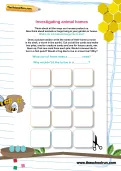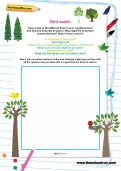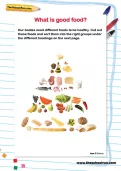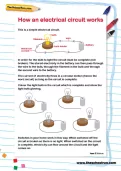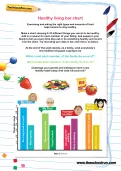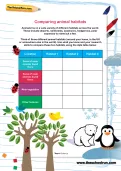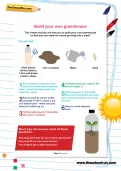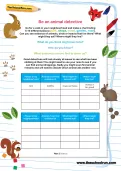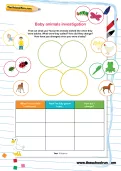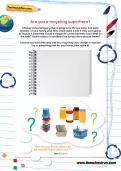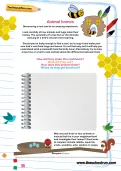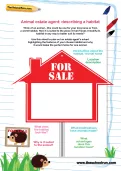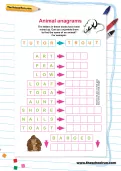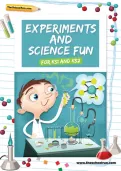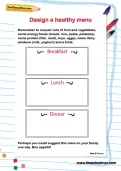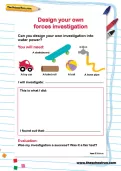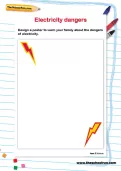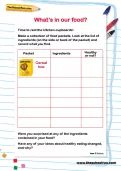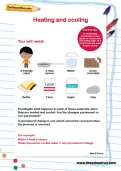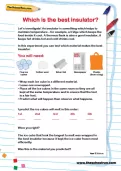Exercising and eating the right types and amounts of food help humans to stay healthy. Make a chart showing 5-10 different things you can do to be healthy. Add in a column for each member of your family. Ask people in your family to tell you every time they eat or do something healthy and record it on the chart. Try recording your data in bar chart form. At the end of the week decide, as a family, what everybody’s new healthy living goal is going to be.
or
Register to add to your saved resources
Already a subscriber? to view this content.
Animals live in a wide variety of different habitats across the world. These include deserts, rainforests, seashores, hedgerows, polar expanses to name but a few. Think of three different animal habitats (around your home, in the UK or somewhere else in the world). Use what you know and your research skills to compare these two habitats using the data table below
or
Register to add to your saved resources
Already a subscriber? to view this content.
This simple activity will help you to build your own greenhouse so that you can observe a seed growing into a plant!
or
Register to add to your saved resources
Already a subscriber? to view this content.
Have a look at the different trees in your neighbourhood and find one birds like to land in. Why might the birds have chosen that tree? Does it have a nest in? Then draw a picture of the tree and label your picture with all the reasons why you think this is a good tree for birds to nest in.
or
Register to add to your saved resources
Go for a walk in your neighbourhood and make a chart listing 5-10 different places (park, shops, wood, garden, road). Can you see evidence of animals, birds or insects that live there? What might they eat? Where might they live?
or
Register to add to your saved resources
Already a subscriber? to view this content.
Find out what your favourite animals looked like when they were babies. What were they called? How did they change? How have you changed since you were a baby?
or
Register to add to your saved resources
Choose some packaging that is going to be thrown away. Ask each member of your family what they would make it into if they were going to recycle it creatively. Choose your favourite idea and be a recycling hero: design a recycled toy or something new for your home, then make it!
or
Register to add to your saved resources
Already a subscriber? to view this content.
Should you be lucky enough to find a nest, try to copy it and make your own bird’s nest from twigs and leaves. It’s not that easy but it will help you understand what a mammoth task the birds have! Alternatively try to draw a bee hive or a bird’s nest and talk about the differences between them.
or
Register to add to your saved resources
Already a subscriber? to view this content.
Think of an animal – this could be one for your local area or from a world habitat. How it is suited to the place it lives? Does it modify its habitat in any way to better suit its needs? Use this sheet to plan out an estate agent’s advert highlighting the features of your chosen habitat and why it would make the perfect home for one animal.
or
Register to add to your saved resources
The letters in these boxes have been mixed up. Can you unjumble them to find the name of an animal?
or
Register to add to your saved resources
Already a subscriber? to view this content.
Beans, gingerbread men, ice, washing-up bottles and cocoa powder – that's all you need to demonstrate key KS1 and KS2 science concepts to your child at the kitchen table. Packed with simple experiments, fun games (Muffled Chinese Whispers, anyone?) and parent-friendly science explanations, our Experiments and science fun for KS1 and KS2 learning pack is all you need to make primary science come to life for your child.
or
Register to add to your saved resources
A worksheet to prompt children to think about how to incorporate healthy food types into their daily diet.
or
Register to add to your saved resources
Already a subscriber? to view this content.
A brainstorm sheet to encourage children to write down everything they know about living things.
or
Register to add to your saved resources
A worksheet to prompt children into carrying out an investigation into the force exerted by water on different objects.
or
Register to add to your saved resources
Already a subscriber? to view this content.
A cutting and sticking activity to help children understand which foods belong to which group.
or
Register to add to your saved resources
A worksheet to prompt children to think about the dangers of electricity and how they could warn others about this.
or
Register to add to your saved resources
Already a subscriber? to view this content.
A sheet encouraging children to look at the ingredients in different food and consider which are healthy and which are not.
or
Register to add to your saved resources
Already a subscriber? to view this content.
An investigation to determine what happens when you heat and then cool down different foods. Children are then encouraged to record their results.
or
Register to add to your saved resources
Already a subscriber? to view this content.
An experiment for children to do at home, which will illustrate the meaning of insulation.
or
Register to add to your saved resources
Already a subscriber? to view this content.
A worksheet designed to illustrate the fact that a circuit must be complete for electricity to flow and a bulb to work.
or
Register to add to your saved resources
